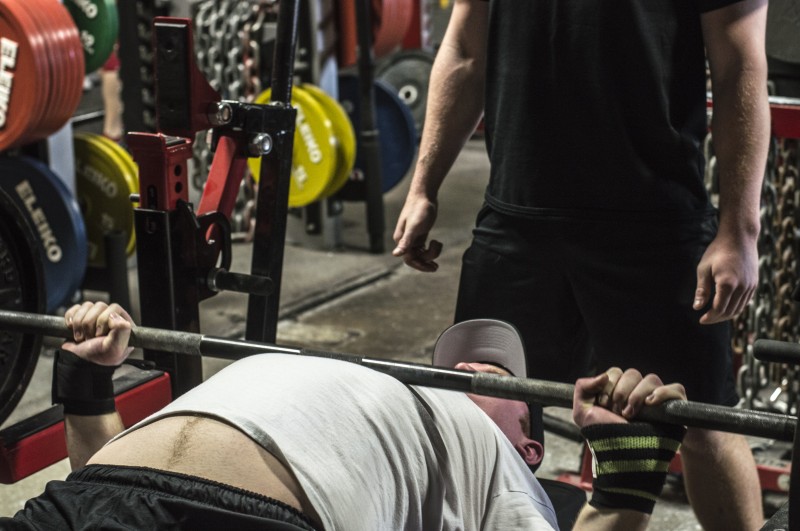
When I first started writing these articles, I wrote one titled "Using the Dynamic Effort Method Dynamically." In that article, I used dynamic effort work in a manner that would seem foreign to powerlifters but that helps teach my athletes how to put force into the bar or into the Earth. This sounds like a very simple thing to do, but it's amazing how many Division I collegiate athletes don't know how to drive into the ground. In this month's column, I'm taking that to the next level (and mainly stealing from Bryan Mann) with a small budget and numerous athletes.
What is velocity-based training?
If you want to go to the expert on velocity-based training (VBT), Bryan Mann is your guy. I'm here to show you how to take his awesome science and make it work in a short period of time with very few bells and whistles. To me, VBT is using velocity as our guide as opposed to percentages of a one-rep max. For example, you would have your athletes perform sets of dynamic effort squats at 0.8 m/s instead of at 55 percent. Now, VBT can and is much more than this, but this is just the beginning of how we use it.
Velocity-based training for dynamic effort work
With dynamic effort (DE) work, we use the guidelines that Bryan Mann has spoken and written about extensively. I've tweaked Bryan's numbers to fit what we need. I'll explain why as I go through this.
First things first, do you have any technology? I have one Tendo unit and several stopwatches. These are all good for helping judge velocity. I recently started using the app Iron Path Pro, which is an awesome $3.99 purchase. To be honest, it doesn't matter what you use to determine velocity as long as you're consistent.
If you have a Tendo unit, here are the numbers that we look for when doing DE work:
- Power lifts, 0.7 m/s
- Cleans, 1.2 m/s
- Snatch, 1.4 m/s and up
- Jerk (we stopped measuring this lift)
As you can see, we have rough numbers similar to what Bryan recommends but with some slight changes. I slow down our Olympic lifts slightly, as I've found that if the speed is too fast with a collegiate athlete, the technique tends to go south. If the athlete is a more experienced lifter, I think adding speed is fine, but with most of our athletes, I need what I call controlled speed. As for the jerk, I found over the years that athletes can become really good at this lift quickly and they tend to get under the bar very well. This becomes a good problem to have, as often the bar speed slows down, but the body speed improves. Unless you hang a Tendo unit from the ceiling and tie it to the athlete's ribs though, I wouldn't use the jerk for this purpose.
RECENT: Which Way Should S&C Go?
As I mentioned earlier, using the Iron Path Pro app has really helped me with DE work and VBT. The numbers come out differently than the numbers from the Tendo unit because it doesn't do averages, but I've found that it gives me some quantifiable data to give to the athletes and coaches.
Let's assume that you have nothing but a stopwatch. You can still use VBT to some extent. Go old school and tell the athlete that he has to achieve three reps in three seconds. Trust me—this isn't perfect because technique can become an issue, but this is when you need to be on your A game as a coach. Don't allow the athlete to cheat. For the bench, three reps in three seconds is a good goal for DE work. For the squat, I don't know a good number because there are many variables. However, this doesn't mean that you couldn't come up with some numbers of your own through some experimentation.
As for the Olympic lifts, this is tough if you don't have any technology available, but we do have our eyes. Watch the lifts and watch the path of the bar. You can get a decent sense of velocity after seeing 50,000 reps. No, Bryan, the art of coaching isn't dead!
Velocity-based training for max effort or modified max effort work
I love using VBT for modified max effort (ME) work. I was talking with Bryan a week ago, and he mentioned what happens as the bar slows down to 0.4 or 0.35 m/s and what will happen next. I said, "Bryan, I'm on the floor!" If the bar hits 0.3 m/s, bad things are coming.
We all know that saving a rep or two can be a great way to improve while not getting beat up. So let's say that you have an athlete do modified ME work for three reps. If repetition two is at 0.3 m/s, cut off the athlete there. He may get the next rep but at what cost? Will the lift be an ugly mess or will the athlete injure himself? It just isn't worth the risk.
What if you don't have a Tendo unit or GymAware? This is where experience steps in. Just like with the Olympic lifts, learn what 0.3 m/s looks like. Athletes have a hard time with this because they often think that failure is a good thing. Always remember this—athletes (and many coaches) will judge a lift based on the metabolic demand of the session. If they sweat hard and feel big, it's clearly a great lift. Our job is to educate the athlete (and the coach) about why this isn't always the best option.
There are some things that I don't think are effective in a team setting using VBT:
- Training until a certain drop off in speed occurs: I've heard of many people doing this. If it works for you, please teach me. What I mean by this is telling an athlete to do sets of two until the bar slows to 90 percent of the best set or of the athlete's best time. But how mentally engaged is the athlete with each and every set? Time every set and often you'll find that an athlete does 95 percent in set one, 93 percent in set two, 103 percent in set three and 89 percent in set four. This is difficult because it wasn't physical fatigue that was the limiting factor but mental fatigue. The athlete "took a set off." This method should be reserved for the advanced trainee.
- Checking velocity at the beginning of a lift and basing the lift off that number: I tried this a few years back and found a similar problem as in the previous example. The athlete has to have the same mental engagement in each and every workout. The other issue I've found is that outside stressors can affect this greatly. There are days when an athlete has to hustle to the workout due to a test and there are days when the athlete walks slowly across campus to a workout. This could just be due to acute fatigue from running to the session that shows a slow, weak athlete at the start. Buddy Morris said it best (I'll paraphrase): the athletes' preparedness not only changes day to day but also hour to hour and minute to minute. Don't let one bad minute change the workout.
These are just two examples of ways to use velocity in your programming that I haven't seen success within a team setting. If you're working in a different setting, these may be great for you, but we've found little success implementing them.
I didn't mention repetition effort (RE) work. There is a reason for that. I don't use any VBT with our RE work. It just doesn't make sense to me because the goal of RE work is to just get some time under tension and build a bigger muscle. So just do the work that your team needs with this and don't overthink RE work and time under tension work.
Hopefully, this article has given you some ideas on how to use VBT in a large team setting. I'm not saying that my way is the best way, but in my current situation, this is what works for me. I promise you that it will evolve, and what works today won't work tomorrow.












2 Comments